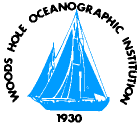|
P.F.J. Lermusiaux,
S.M. Kelly, P.J. Haley, Jr. W.G. Leslie, M.P. Ueckermann, C. Mirabito Massachusetts Institute of Technology
|
Timothy F. Duda
Woods Hole Oceanographic Institute
|
|
Ongoing MIT-MSEAS Research NSF Shelf-IT Supported Publications Background information |
| This research is sponsored by the National Science Foundation | |||
Ongoing MIT-MSEAS Research
Internal tide generation and propagation near continental slopes is being studied using a four-dimensional numerical simulation and diagnosis approach. The purpose is to explain observed variability in internal tides and the nonlinear waves they spawn. The study concentrates on long wavelength linear internal waves (internal tides) generated from subcritical tidal flow (current speed less than wave speed), ubiquitous around the world. Three internal tide effects are being examined: variable generation, heterogeneous propagation (i.e. focusing), and conversion to nonlinear waveform. The first two effects, largely unexplored thus far, will create wave energy density structure, and may give spatial/temporal structure to the nonlinear conversion process. A set of simulations are being performed with the MIT Multidisciplinary Simulation, Estimation, and Assimilation System (MSEAS), mostly with the hydrostatic primitive equation model already tuned at mesoscales via comparison with data. Modeled configurations range from idealized bathymetric, stratification, and flow conditions to realistic conditions obtained via data-driven modeling. Inter-comparisons of the collected results will divulge the physics of variable four-dimensional internal tide generation and propagation, with the intent of describing how the process occurs in the real ocean. The new MSEAS non-hydrostatic model will then be used to study nonlinear conversion processes, forming about 20% of the project. Applicability of the results to the real ocean will be verified via comparison to remote sensing and in situ data from a one-month long experiment. The main application region is the Middle-Atlantic Bight because large constraining data sets and available tuned model, but Asian Seas areas, also with existing models and data sets, will be briefly explored to examine interregional differences.
Shallow Water 2006 (SW06) Re-Analysis
A data-driven re-analysis of SW06 has recently been carried out. In this re-analysis a number of areas have been addressed : improved initial and boundary conditions and feature models (FM) (see below); the vertical discretization now consists of 100 optimized vertical levels; atmospheric forcing now includes improved E-P and direct fluxes from WRF/NOGAPS; amplitudes of tidal forcing have been corrected; data assimilation is weaker and more frequent with shorter space scales; and model parameters of vertical mixing (wind mixing, PP background mixing), horizontal mixing and bottom friction have been re-evaluated.
An important compenent of the re-analysis was the significant improvement of the model initial and boundary conditions. This was achieved through the inclusion of additional synoptic data (WODB, GTSPP) and pseudo profiles to bolster the shelf-break front; correcting the WOA climatology for the slope to match the 2006 conditions; better defining the shelfbreak T/S front FM (steepness and location of foot); improving the Gulf Stream T/S FM based on synoptic data and utilizing transport feature models for the Gulf Stream, slope recirculation gyre and shelfbreak front.
Model output files from the best simulation of the SW06 conditions can be found here.
Publications
NSF Shelf-IT Supported Publications
| Top of page |
Background information
Internal tides and/or nonlinear internal waves have been observed to occur throughout the worlds oceans wherever two conditions are met: energetic tidal flows encounter suitably sloped seafloor topography, and the stratification is appropriate for internal waves. These waves are a primary source of energy for diapycnal mixing of buoyancy and nutrients in many outer continental shelf areas of the world. We are studying internal-tide spatial variability, temporal variability, and intermittency at a shelfedge region, including processes controlling internal-tide conversion into highly energetic nonlinear waves as the internal tides propagate shoreward. Typically, tidal flow with subcritical Froude number generates long baroclinic waves of tidal frequency (internal tides, IT) that move onto the shelf, develop localized zones of high energy density, and spawn nonlinear internal waves (IWs). To provide important information regarding this process we are investigating generation and propagation of the precursor internal tides, largely through computation and analysis of model fields. Explaining causes and effects of IW variability observed in the field is a major goal (see next section). The ultimate conversion of these potentially nonlinear (but hydrostatic) internal tides to either nonlinear non-hydrostatic short waves or stable nonlinear long waves (Helfrich and Grimshaw, 2008) is sensitive to propagation details that we are investigating, such as horizontal focusing. However, that final conversion to short waves is a separate issue that we will address in the latter stages of this work after thoroughly studying internal tides. Note that this process forms only one class of nonlinear IWs, with other classes being formed directly from hydraulically controlled flow over topographic sills or slopes.
This project is a collaboration between the MIT Multidisciplinary Simulation, Estimation, and Assimilation System (MSEAS) data assimilation and modeling group and a WHOI wave physics research group. The reason for bringing these groups together is that the success of the project hinges on the quality of the modeling. Model adjustments, enhancements, and testing (i.e. development) are required. Although some development is required, existing models already tuned to several shelf-edge regions are being applied to the problem, so numerical aspects of the work are limited and leveraged from other efforts. Decisions regarding model setup, analysis of model fields, their interpretation in terms of wave dynamics, and comparison to field data are being undertaken jointly by the two groups.
| Top of page |




